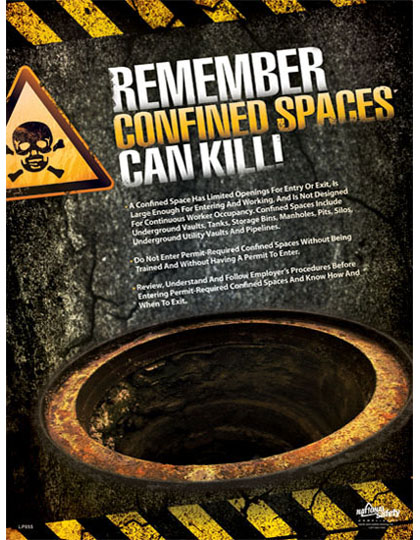The safety poster shown below is graphic, but it conveys excellent information for those persons whose jobs require them to work in areas considered to be confined spaces. These vessels, etc. are normally sealed so the dangers within, whether it is high-pressure, hot, or toxic materials, or gases, mechanical or electrical hazards, stay within. When a human enters to inspect or service what’s inside is when the danger begins.
According to OSHA, many workplaces contain spaces that are considered “confined” because their configurations hinder the activities of employees who must enter, work in, and exit them. Confined spaces include, but are not limited to underground vaults, tanks, storage bins, manholes, pits, silos, process vessels, and pipelines. OSHA uses the term “permit-required confined space” (permit space) to describe a confined space that has one or more of the following characteristics: contains or has the potential to contain a hazardous atmosphere; contains a material that has the potential to engulf an entrant; has walls that converge inward or floors that slope downward and taper into a smaller area which could trap or asphyxiate an entrant; or contains any other recognized safety or health hazard, such as unguarded machinery, exposed live wires, or heat stress. Repeating, OSHA’s definition of “Confined space” means a space that:
(1) Is large enough and so configured that an employee can bodily enter and perform assigned work; and
(2) Has limited or restricted means for entry or exit (for example, tanks, vessels, silos, storage bins, hoppers, vaults, and pits are spaces that may have limited means of entry.); and
(3) Is not designed for continuous employee occupancy.
“Acceptable entry conditions” means the conditions that must exist in a permit space to allow entry and to ensure that employees involved with a permit-required confined space entry can safely enter into and work within the space.
According to NIOSH, when the entry of a worker is necessary, prior to entry into any type of confined space, several things must be done to ensure the safety of the persons required to work there. The atmosphere should be tested, at all levels – top, middle, and bottom. The area should be well ventilated with blowers or fans, and re-tested to ensure that it is ventilated correctly before anyone enters. There are many locations that have insufficient air movement, which results in oxygen deficiency, flammability, or toxic situations. Persons inside may be involved in welding, cutting, or brazing operations, and others may be painting, scraping, sanding, or degreasing. Workers must have the appropriate personal protective equipment, such as hardhats, gloves, rubber boots, and the proper type of respirators. Some may need air purifying ones, those that filter dangerous substances from the air, or air supplying types that furnish safe breathing air from a tank or uncontaminated area nearby. Only air-supplying respirators should be used in confined spaces where there is not enough oxygen.
Other hazards of confined spaces include extreme temperatures, engulfment hazards, such as loose materials in bins – sand, coal, grain – materials that a worker could fall into and suffocate. Being in small spaces also amplifies noise; some are slick and wet, adding to the risk of electric shock, and others may have falling objects dropped into the area by work being done above the entrance. All of these hazards add up to the fact that it takes very special kinds of workers that are willing to do this type of work, and companies that do their very level best to meet the needs and requirements to keep these folks safe.

Tomorrow, we will discuss the way these workers should be protected by having attendants at the entrance, and rescue operations at the ready, as well as a checklist that contains recommendations for a safe entry. Please stay tuned…………………………
Source: OSHA, NIOSH
Finally a person that puts some real work into a blog. I do like what you have done with the blog.
My site is on [url=http://healthyrecipeforweightloss.blogspot.com]Healthy recipes for weight loss[/url].